Greece
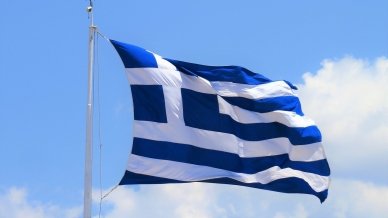
Greece… Grand ruins of the ancient civilization and ultramodern metropolitan cities, beautiful beaches and mountains, three hundred sunny days during a year, and just a paradise climate.
The country is worth visiting not only for beach recreation. The antique ruins are believed to be a perfect site for thinking about universal and eternal things. And the Athonite and Meteora monasteries leave the recurring light of faith and hope for the best in human souls.

General Information
Greece is a homeland for everything that constitutes the basis of civilized life — democracy, science, culture, technologies, and sports. Several millennia ago, Greek scientists and philosophers gave an impulse for the development of fundamental sciences, culture, literature, and state institutions of modern human society.
Historical Background
The history of Greece commenced with Crete, the largest Greek island settled by the Minoans — the first Bronze Age civilization. Everybody knows the myths about Icarus and Daedalus or Labyrinth at Knossos.
The Cretans were actively building their state. They established strong commercial ties with Ancient Egypt, developed culture, and extended the poleis. The Minoan civilization was gradually changed by the Aegean, the influence of which extended far beyond the island to the mainland.
Then there were several lost wars. First, the Cretans were defeated by Thebes, and later — by the mighty Macedonian Kingdom that created the prerequisites for the beginning of the Hellenistic period in the Mediterranean area. The Aegeans became a part of the Kingdom.
The death of Alexander the Great entailed the division of his possessions into separate city-states and thus made them less powerful. As a result, those lands became a part of the Roman Empire for many following years. Nonetheless, even the Roman Empire underwent the same when Theodosius I died. After the disuniting, Byzantine became its legal successor for the next thousand years.
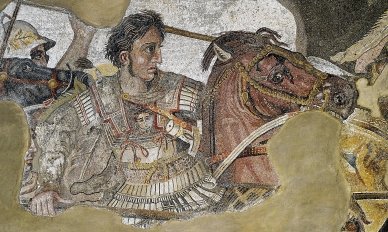
Mosaic depicting Alexander the Great (detail), House of the Faun, Pompeii
In the 15th century, Byzantine became enslaved by the Ottomans. And for the Greeks, it was challenging to retain Orthodox traditions and the language. However, the Greek autonomies called millets were purposefully created to help preserve the elements of the national identity.
Greece gained independence in 1830, and a couple of years later, the monarchy was established. At different times, various monarchs ascended the Greek throne. For example, there were Otto of Greece (the descendent of the House of Wittelsbach), George I (born Prince William of Schleswig-Holstein-Sonderburg-Glücksburg), and the other kings from the Glücksburg dynasty. The monarchy was abolished only once, in 1946, for a short period. That was the time of the Civil War against the Communist Party of Greece. In 1949, the monarchy was restored.
In April 1967, the monarchy came to an end after a coup d'état by the Regime of Colonels. So the junta era substituted the days of the kings and reigned in the country till 1975.
After the junta overthrow, a national referendum was held in Greece. The citizens confirmed their will to live in a parliamentary republic.
At present, Greece is a country where tourism (15% of GDP), agriculture, and industry are the main sources of revenue. In 2001, it got the status of a developed country but then lost it in 2013 after economic hardships in the background of the global crisis. That has been the first incident in the world.
Greece has been a member state of the UN since 1945, NATO — since 1980, and the EU — since 1981.
Greek is the only official language. The religion is Orthodoxy, and the euro has been the official currency since 2001.
Geography and Climate
This small country on the southern Balkans is washed by the Aegean Sea, the Sea of Marmara, the Sea of Crete, the Libyan Sea, and the Ionian Sea. However, we may also say that the marine border includes only the Mediterranean Sea because all five seas constitute a part of the Mediterranean aquatic area.
Greece borders Bulgaria, Albania, North Macedonia, and Turkey.
The territory constitutes the mainland, the Peloponnese, and 2,000 islands, including Crete, Lesbos, and Euboea.
The Greek landscape is versatile: rocky and forestless mountain ranges like Olympus, Pindus, Parnassus, and Taygetus have stretched within 25% of the country’s territory. Many creeks, beaches, valleys, bays, and channels make the coastal area truly picturesque.
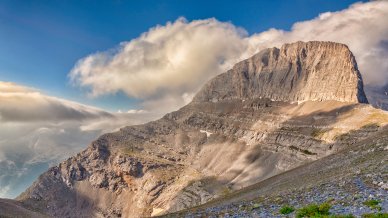
Mount Olympus, Greece
Such a diversity lures millions of tourists, each of whom has their own idea of a perfect vacation. Some of them dream of luxurious beaches with turquoise water while others struggle to experience the thrill of mountain trails and caves or indulging in the world of antiquity during the guided tours of the Greek sightseeing places.
Greece will not confound people’s expectations. Those fond of carefree beach recreation should go to the resorts of Halkidiki, Crete, Rhodes, and Corfu. Mount Olympus and the Monasteries of Meteora floating in the air will conquer the hearts of the most fearless mountain climbers. And the ones who prefer exploring the ruins of ancient cities can opt for a bus or a walking tour of the Acropolis of Athens, Asclepeion, Delphi, Corinth, and other splendid places.
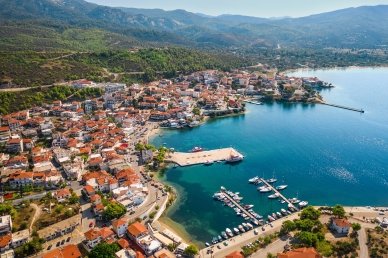
Halkidiki, Greece
Greek climate is versatile and ranges from the Mediterranean to the continental. In general, it varies by the locality: the closer the mountains, the colder the summer and winter. However, there is one common weather rule regarding different regions: mild winter, long and warm spring, dry and hot summer, and long mild autumn.
The high season begins in July when the sea becomes warm enough and remains pleasantly heated to swim there till November.
Between December and June, the best way to spend time in Greece is to go on the guided tours of legendary sites and shopping tours. The places are less crowded and prices are much lower.
Directions
Getting to Greece is possible by plane, bus, train, and car. However, the latter two options are a bit more complicated and time-consuming.
Air connectivity between Greece and other countries is well-developed. As a rule, there are regular flights to Athens, Thessaloniki, and the islands.
Bus trips to Greece from the European countries may take more than 36 hours and cost around $75. You may travel to the other Greek cities and islands by internal air flights, buses, and trains.
Accommodation
Greece is a country of tourists, so there is always a demand for accommodation. In most cases, travel agencies deal with the search for a place to stay. However, some people prefer to do that by themselves.
As well as in the other resort-oriented country of high and low seasons, Greece has its own peculiarities of the hospitality industry. Between July and October, the hotels are most crowded, but spring and winter are calm periods. So consider this when planning an individual trip.
Prices for hotel rooms are much the same as in Turkey: an average check ranges from €25 to €40 per room.
- FarOut Beach Club is a small two-star hotel in Mylopotas with an excellent beach nearby and a swimming pool. There are rooms with bathrooms, air conditioning, and balconies. Besides, the rooms have fridges, minibars, safes, and TV sets inside. Free Wi-Fi.
- Zorbas is a two-star hostel in the historical part of Athens. The shower is shared, but there are bathrooms and air-conditioning in each room. The hostel is located close to the Arch of Hadrian and Syntagma Square. Free Wi-Fi.
- Real Palace is a three-star hotel in Malia, Crete. Almost all rooms have a balcony, a bathroom, and air-conditioning. There is also a big swimming pool and free Wi-Fi.
- Albatros is a two-star hotel in Skopelos. Each room is well-furnished, clean, and cosy; there is also air-conditioning and a bathroom. The balconies overlook the magnificent landscapes. Free Wi-Fi.
- Blue Lake is a hotel in Keri (Zakynthos) with studio rooms located a short walk from the sea. Though the rooms are plainly furnished, there are enough facilities to have rest with comfort. The hotel also offers a swimming pool and free Wi-Fi.
The other option is renting an apartment or a house, which will be particularly suitable for a group of travellers or a family with children. Finding accommodation is possible via the Greek letting websites like https://www.xe.gr/, https://www.spitogatos.gr/ or https://www.tospitimou.gr/main/index.jsp. Though the information is in Greek, you may always use Google translator.
You may also look for a place to stay by yourself after arrival. The most convenient way will be living in a hotel for a couple of days, which will enable you to look for the perfect option without any haste.
But how can you do that if you do not speak Greek? Learn the word ΕΝΟΙΚΙΑΖΕΤΑΙ that means for rent. The advertisements may be found on every street, often stick to the special boards, but sometimes they may be seen directly on houses or posts.
The second step is to communicate with the landlord or tenant in a mixture of English, Greek and words of unknown origin. Greeks are very temperamental and emotional and use vivid body language.
Having taken a look at the apartment, ask for the latest utility bills. It will help you better understand how much will be spent apart from the rental. Bear in mind that the most expensive article on the bill is electricity, and the cheapest is water (though there has always been a freshwater shortage in this maritime country!).
Places to See

Purchasing a tour of Greece enables us to feel the antiquity in real life. And that will come about not just through the myths about Achilles, Prometheus, Perseus, and Heracles that we would read in childhood. The legendary palaces and temples of gods, natural landscapes have existed up to date. They have become the best Greek sightseeing attractions that every person should visit at least once in their life.
Athens
The Greek capital is a concentration of the main monuments of antiquity. It is the place where the most known places to see in the country are located.
So how to embark on a guided tour and what to see?
An ordinary day in Athens is a boiling heat and not the best time for walking around the city. The evening is a better time to begin the acquaintance. Then the heat weakens, and the ancient ruins look more impressive in the twilight.
Go for a walk late in the evening or even at night: the guided tours of Athens at this time are outstanding. It is an opportunity to indulge in the bright and dynamic life of the city that never seems to sleep.
Start with Syntagma Square, the name of which means the order (in ancient Greek). Here, the main government institutions of Greece are based, including the Parliament building and the former Royal Palace that has become a part of the Parliament complex.
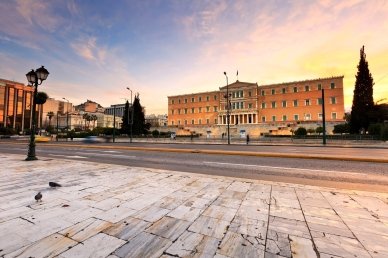
Syntagma Square, Athens
A stunning fountain is warbling with crystal clear water in the centre of Syntagma. The soldiers of the elite division of the Presidential Guard, called evzones, stand the guard of honour at the Tomb of the Unknown Soldier. In total, there are 120 of them, but during working days, not all evzones take the guard duty. You may see the full complement of the division only on the days of national holidays when the military orchestra is performing on the square, and the changing of the guard ceremony is conducted with a peculiar festivity.
The next must-see place is the legendary Acropolis of Athens, surrounded by the curved Plaka streets to the north and east, one of the antique neighbourhoods of the capital. Several millennia ago, it was a fortified hill with constructed fortresses and temples. Among the preserved temples, there is the Parthenon (the main temple of ancient Athens), the Temple of Athena Nike, Erechtheion, the ionic columns, and several other monuments of antiquity.
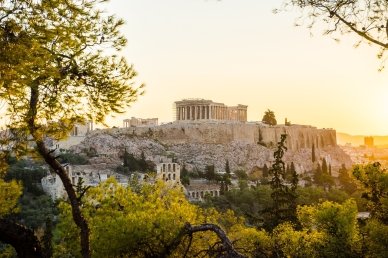
Acropolis of Athens
Down the northern slope of Acropolis, we will end up in Agora — the antique market square, where the most important gatherings of residents took place in Ancient Greece. Besides, there is also the Temple of Hephaestus, the patron god of fire.
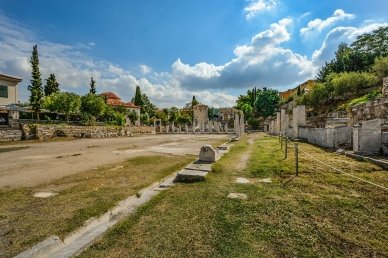
Agora, Athens
After the tour of Acropolis, if you do not feel tired, you may walk across the Plaka streets or roam around the souvenir shops. The luckiest tourists sometimes manage to purchase real treasures of antiquity for very low prices.
Crete
The very first reason why tourists should go to Crete is the fact that here Greece began. Start your journey with Knossos Palace.
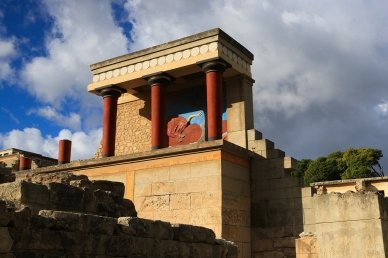
Knossos Palace
Longe ago, in this centre of the Minoan civilization, there were more than 1,200 rooms with a capacity of 10,000 people — an entire modern town. Complex paths, the multitude of corridors and crossings of the palace make it resemble a mythical labyrinth, which is assumed to have been constructed for King Minos by Daedalus.
Why mythical? Knossos Palace had been regarded as just fiction until it was discovered at the end of the 19th century.
Minos Kalokairinos conducted the initial excavations, but the war with the Turks of 1898 wiped out all his efforts and victories. The battles destroyed his house, where he kept the collections and research materials. Besides, the Turkish government forbade conducting all further works.
Later, Sir Arthur Evans got all the credits of pathbreaker to Knossos. In 1900, this noble English gentleman purchased the lands of the earlier excavations, hired people, and began the process. In five years, they eventually excavated the Palace. But Evans was interested in the finds of the new era (dated earlier 1450 BC), so he ordered to destroy the layers of the later period.
Who knows, perhaps the Labyrinth of the Minotaur is not a legend, and its time is yet to come.
Rhodes
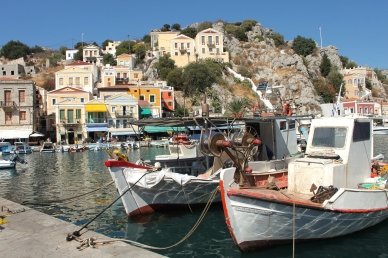
Rhodes, Greece
The fourth-largest Greek island resembles the elongated ellipse by its shape. The terrain is mostly mountainous, and the sand beaches with crystal clear water stretch along the coast.
The Rhodes climate is excellent for those who are not in favour of starching heat. Chill northeastern winds lower the summer temperature to +25°C — +27°C.
The history of Rhodes is enriched with mythical events and heroes as well as the history of Greece in general. The glorious past is depicted in the monuments of architecture, the masterpieces of the Rhodes sculptures and pottery craftspeople. The most famous is a statue of Nike of Samothrace, currently exhibited in the Louvre.
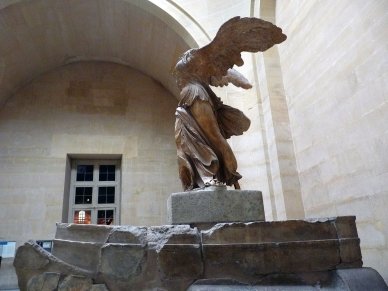
Nike of Samothrace
Many buildings that date back to the antique era and Middle Ages have been preserved up to date. For example, the Palace of the Grand Master of the Knights of Rhodes (Kastello) used to be a shelter for the Knights Hospitaller. A nearshore village Lindos was constructed between the 8th and 6th centuries BC. Its Acropolis is considered the second largest and most significant after the one of Athens.
On the eastern coast of Rhodes, there is the Epta Piges (Seven Springs) National Park, which can perfectly well become the eighth wonder of the world. It is a matter of a spring breaking the surface at seven places simultaneously and then cascading down with stunning waterfalls into river Loutanis.
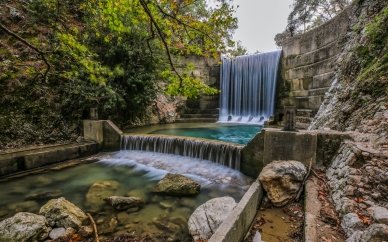
Epta Piges (Seven Springs) National Park
The bravest tourists are offered a guided tour of a narrow 150-metre tunnel built in the 1930s. They have to walk this distance barefoot, one by one, and in the darkness. The thing is that light hits the tunnel only through a small ventilation shaft. Those who have taken the risk then tell how overwhelming the experience was and how much thrill they felt.
The Valley of Butterflies in Rhodes is one more place on the island, where the multitude of tourists aspires to delight in the vibrating red-blue myriads. As a rule, it occurs in June when the Jersey tigers (Euplagia quadripunctaria) begin procreating.

The Valley of Butterflies in Rhodes
The kaleidoscopes are of stunning beauty, but the local government has started considering the ban to visit the valley during the mating season. To take a glamorous selfie, the tourists disturb and scare beautiful insects, thus making them soar upwards.
Under those circumstances, the majority of butterflies become so stressed that they die without laying eggs. In this way, if the visitors are trying to make the kaleidoscope of butterflies move up in the air, they run a risk of being fined. It is increasingly likely that the authorities will even prohibit guided tours between May and November.
This 6-km reserve is located 30 km from the principal city of the island — Rhodes. The fauna here is versatile and is not limited to butterflies. In the gorge, you may see rare species of turtles, birds, and even crabs due to several brooks and waterfalls flowing through the entire territory.
The tours of the Valley of the Butterflies are very comfortable. Though the terrain is mountainous, there are benches, stairs, and viewing decks carved right in the rocks every 50 metres. You can have a bite in a small tavern as well.
The Kalopetra Monastery Chapel evokes a peculiar interest. A nobleman built it at the end of the 18th century. It was meant to be a place for uttering the prayers for the health of his daughter. He brought the girls there to give her an opportunity to breathe the healing air of mountains.
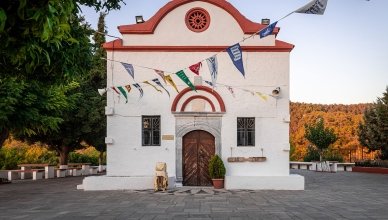
Kalopetra Monastery Chapel
Such a guided tour is only for physically fit and healthy people because climbing the mountains entails a considerable strain on the heart and lungs. Not everyone can cope with it, but poor health is not a reason to refuse the Rhodes climbing.
Right at the foot of the mountains, there is Lower Park. There you can feast eyes upon the butterflies and have rest by the lake in the shadows of trees.
Mount Athos and Meteora
In eastern Greece, on the edge of Chalkidiki, there is a place that is so meaningful for every Orthodox Christian. It is Mount Athos, the centre of the world Orthodox monasticism.
It is a complex of 20 monasteries that still use the Julian calendar, the first of which appeared on the holy mountain between the 5th and 7th centuries. Most of them are Greek, but there are also some Georgian monasteries.
Athos is the only place in Greece where women are not allowed to enter. If this prohibition is broken, a person may be fined and even get one-year imprisonment. It is not that easy for men to get there either. They need to obtain special permission called diamonitirion.
Apart from the churches, there are also 12 sketes — secluded monasteries where monks praise the Lord all day and night.
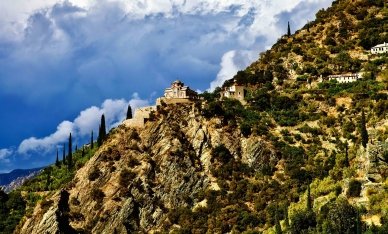
Mount Athos, Greece
Not far from Kalabaka, a town in northern Greece, the Monasteries of Meteora seem to be floating in the air over the Mountains of Thessaly. Long ago, there were 22 (according to the other data, 24) of them, but only six have been preserved. The rest were either destroyed by the wars and time or left in ruins. During World War II, the monastic treasuries were looted, and only a modest part of them has remained undamaged.
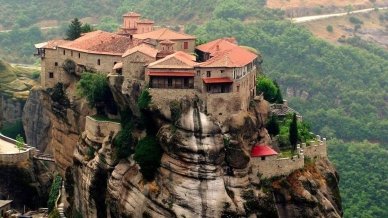
Monasteries of Meteora
It is no exaggeration to say that this place is unique enough in its distinct architecture as a combination of natural wonder and human genius. The monasteries are built on natural rocky pillars, 600 m above sea level. It is not still clear how the monks managed to elevate the processed stone blocks by hand-carry, to build the chapels, churches and cells undergoing the risk of falling.
Among the six Meteora monasteries, four are for men, and two are for women. The Monastery of Great Meteoron, built at the beginning of the 16th century, is the biggest. One will need to follow an uneasy path of 154 high stairs to get there.
However, those who have accomplished this goal will be rewarded with a spectacular view of the ancient monastery buildings in their original state and a breathtaking mountainous landscape. Visitors may also attend the folk museum, hospital, cathedral, and altar. They will be surprised how everything functions and has been in use for monks up to date.
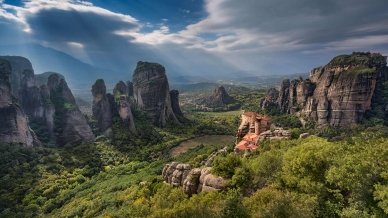
Meteora, Greece
Apart from the Monastery of Great Meteoron, there are the Monastery of Rousanou (for women), the Monastery of Varlaam, the Monastery of St. Nicholas Anapausas, the Monastery of St. Stephen (for women), and the Monastery of the Holy Trinity.
In the 1930s, an extensive reconstruction of the itineraries took place. Earlier, a rope ladder and wooden pathways were the only possible but risky ways to get to Meteora. After the alterations, the stairs were carved in the rocks.
Even at present, a guided tour is a complicated process. In general, it will be most suitable for those who have stamina and are physically fit and healthy. It is free of charge for Greek citizens but costs €3 for foreigners.
Food
If you have been lucky to visit Mediterranean countries like France, Italy, Spain, and Cyprus, Greek cuisine is not going to surprise you a lot. The majority of dishes will turn out to be quite well-known.
Nonetheless, they still have peculiar features. That is the enormous love of Greeks to herbs and spices, which are used very often and in larger volumes than in other Mediterranean countries.
The other specific feature of Greek gastronomy is the abundance of cheeses. No other nation in the world eats as much cheese as Greeks do: an average person consumes not less than 25 kg of cheese per year.
Some of the products of Greek cheese making are known far beyond the country. For example, salty and slightly tart Feta cheese has caught the fancy of many people and found its place amongst salad recipes, sandwiches, and baked puddings.
And yet, what should a visitor to Greece try? Let us make up a sample menu of a Greek dinner.
We may start with avgolemono, a soup that contains raw eggs and lemon juice as the main ingredients. At first, it is necessary to cook pastina in a meat broth and then add a mixture of eggs and lemon to thicken the soup. Serve it with dill, parsley, and spring onions.

Greek soup avgolemono
The second course is a variation of dolma called dolmades, that is, small grape leaves rolls. Besides, we will cook moussaka — a moist and savoury baked pudding based on eggplant and ground meat.
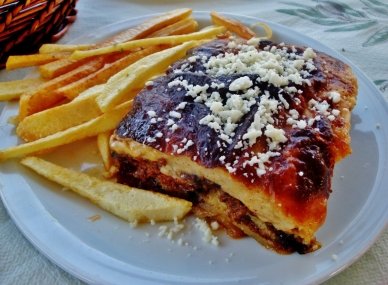
Greek moussaka
Let us complement this splendor with a widely known Greek salad called meze (appetizers served in small portions that originate from Turkey) and tzatziki sauce (a dip made of fresh cucumbers, garlic, dill, parsley, and mint). If you have ever tried the Bulgarian tarator, you will be surprised how much it resembles tzatziki.

Greek meze
The dessert will constitute Greek honey cookies (melomakarona) and cinnamon deep-fried donuts (lokma). As a drink, let us choose something exclusively Greek.
Those in favour of strong spirits will enjoy Metaxa, grape distillate combined with local aromatic herbs. The drink is produced solely in Greece, and what is more, its recipe has been kept in secrecy for many years.
Greeks also often serve anise-flavoured aperitif called ouzo and white wine of 11% ABV — retsina.
Greece is one of the best places for spending an excellent vacation and acquainting with the history of the world civilization. You may just delve into the milieu of Greek citizens — noisy, cheerful, and extremely positive people. Kalimera! — that is what this marvellous country is saying to the world. Kalispera! — that is what its guests are replying.
FAQ
What is the old name for Greece?
The ancient name for Greece is Hellas or Hellenic Republic, which is still the country's official name ("Elláda" in modern Greek).
Is Greece a large country?
Greece is a moderately sized country with a land area of about 131,957 square kilometers.
What is Greece's population?
Greece has a population of approximately 10.7 million people.
What is the capital of Greece today?
The capital of Greece is Athens.
What language is mostly spoken in Greece?
The official language spoken in Greece is Greek.
What type of government is Greece under?
Greece is a parliamentary republic, with a President as the head of state and a Prime Minister as the head of government.
Is Greece doing well economically?
Greece has faced significant economic challenges, including a debt crisis, but it has been making gradual improvements in recent years. Economic recovery remains a work in progress.
Is Greece a member of the EU?
Yes, Greece is a member of the European Union.
Is Greece on the euro?
Yes, Greece uses the Euro (EUR) as its currency.
Is Greece in the Schengen zone?
Yes, Greece is part of the Schengen Area, allowing passport-free travel across member states.
What is Greece's main religion?
The main religion in Greece is Eastern Orthodoxy, specifically the Greek Orthodox Church.
What are the two most famous cities within Greece?
The two most famous cities in Greece are Athens, known for its historical sites and as the birthplace of democracy, and Thessaloniki, known for its rich history and vibrant cultural life.
For what is Greece famous for?
Greece is famous for its ancient history, archaeological sites like the Acropolis, beautiful islands, Mediterranean cuisine, and significant contributions to philosophy, democracy, and the arts.
What are 10 main foods the Greeks eat?
Common Greek foods include Moussaka, Souvlaki, Greek salad, Feta cheese, Olives and olive oil, Dolmades, Spanakopita, Tzatziki, Gyros, and Baklava.
What is the best time to visit Greece?
The best time to visit Greece is during the spring (April to early June) and autumn (September to October) when the weather is pleasant, and there are fewer tourists.
Is it safe to travel to Greece right now?
Generally, Greece is safe for tourists. However, visitors should stay informed about current conditions and exercise standard safety precautions.
Is it expensive for tourists in Greece?
Greece is generally more affordable compared to some other European destinations, but costs can vary greatly depending on the location and time of year.
Can people live in Greece with an EU passport?
EU citizens can live in Greece without a visa but may need to register and obtain a residence permit for longer stays.
Do I need a visa to visit Greece?
Visa requirements for Greece depend on your nationality. Many non-EU citizens need a visa for longer stays, while short visits are often visa-free for certain nationalities.







